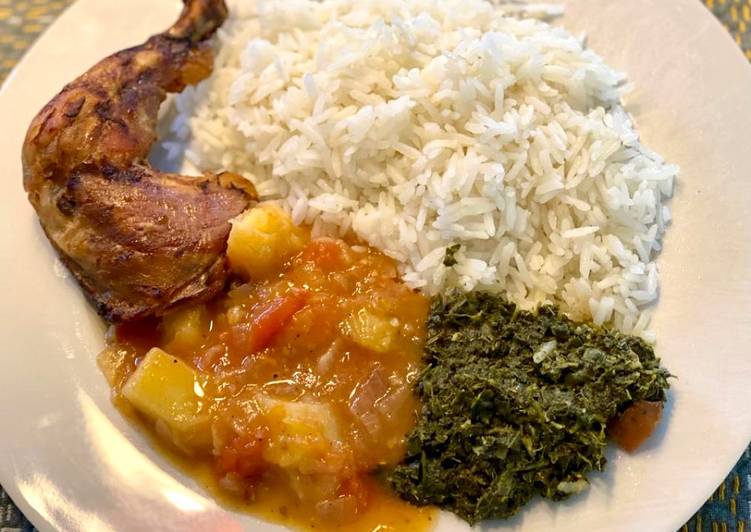Cassava leaves (Kisamvu) and potato & tomato sauce
Cassava leaves (Kisamvu) and potato & tomato sauce. Cassava, yams (Dioscorea spp.), and sweet potatoes (Ipomoea batatas) are Cassava-based dishes are widely consumed wherever the plant is cultivated; some have regional, national Frozen cassava leaves in a Los Angeles market. Cassava undergoes post-harvest physiological deterioration (PPD). Most RARE Vegetables In This World!!!
 Cassava is similar to yams and taro, and people can use it in similar ways to a potato. It is possible to use tapioca starch to make gluten-free. Cassava is a nutty-flavored, starchy root vegetable or tuber. You can cook Cassava leaves (Kisamvu) and potato & tomato sauce using 20 ingredients and 10 steps. Here is how you cook it.
Cassava is similar to yams and taro, and people can use it in similar ways to a potato. It is possible to use tapioca starch to make gluten-free. Cassava is a nutty-flavored, starchy root vegetable or tuber. You can cook Cassava leaves (Kisamvu) and potato & tomato sauce using 20 ingredients and 10 steps. Here is how you cook it.
Ingredients of Cassava leaves (Kisamvu) and potato & tomato sauce
- Prepare of Cassava leaves.
- It's 2 cups of washed and shredded cassava leaves (raw).
- It's 1/2 tbls of garlic paste.
- It's 1 of medium onion chopped.
- It's 1 of large tomato.
- It's 2 1/2 cups of coconut milk.
- You need 1 of chilli pepper of your choice (I used green habanero).
- It's to taste of Salt.
- It's 2 tbls of lemon juice.
- Prepare 1 cup of water.
- It's of Potato sauce.
- Prepare 2 of medium russet potatoes.
- Prepare 1 of large tomato.
- You need 2 tbls of lemon juice.
- You need 2 tbls of tamarind paste (optional).
- It's 1/2 cup of chicken/vegetable broth.
- It's 1 tbls of garlic paste.
- Prepare 1 of medium onion chopped.
- It's to taste of Salt and pepper.
- Prepare 1 tsp of cayenne pepper.
Native to South America, it's a major source of calories and carbs for people in developing countries. It is grown in tropical regions of the world because of its ability to withstand difficult growing conditions — in fact, it's one of the most. Cassava is prepared and eaten with remarkable versatility. It is used in much the same way as potatoes are in the West because of its delicate flavor and starchiness.
Cassava leaves (Kisamvu) and potato & tomato sauce step by step
- For the cassava leaves: Sauté the garlic and onions until golden brown and add the cassava leaves. Stir to combine the ingredients together. Add water and salt and bring the pot to a boil until the water reduces halfway..
- To the boiling cassava leaves, add a cup of the coconut milk and allow to boil over medium-high heat for 3-5 minutes..
- Dice the tomatoes into 1/2 inch pieces and add to the cassava leaves. Reduce the heat to medium and allow the cassava leaves and tomatoes to simmer and cook for a further 5 minutes.
- Add the rest of the coconut milk, the whole habanero pepper and lemon juice and stir to mix well. While stirring you can gently poke the habanero pepper to release its flavours while the cassava leaves continue to cook..
- Allow the cassava leaves to simmer until the coconut milk reduces and thickens..
- Remove from heat and set aside to serve..
- For the potato sauce: dice the potatoes into 1/2 inch cubes and bring to a boil until the potatoes are halfway cooked. Drain and set aside.
- In a pot, sauté the onions and garlic until golden brown and add the diced tomatoes. Stir to combine. Then add the potatoes and stir to combine the ingredients together..
- Add the chicken/vegetable broth and bring to a boil. Now add the tamarind paste, lemon juice, salt/pepper & cayenne pepper and allow the sauce to simmer until it thickens..
- Turn heat off and serve the potato sauce along with the cassava leaves with a side of grilled chicken and coconut rice..
Being so often compared to the potato, which few Westerner's would willingly consent to live without, this humble tuber is impressive. leaves cassava comes with salient features to provide advanced mechanisms. leaves cassava is constructed using multi-level architecture to reduce kitchen labor to a great extent. In case of electric leaves cassava, it is necessary to ensure that a proper insulation of the body and handles is provided. Cassava leaves can supply a good source of vitamins and protein which can also be consumed after cooking. Cassava, Manihot esculenta, is a perennial shrub in the family Euphorbiaceae grown primarily for its storage roots which are eaten as a vegetable. Important Instructions: cassava must be cooked—raw cassava is poisonous.